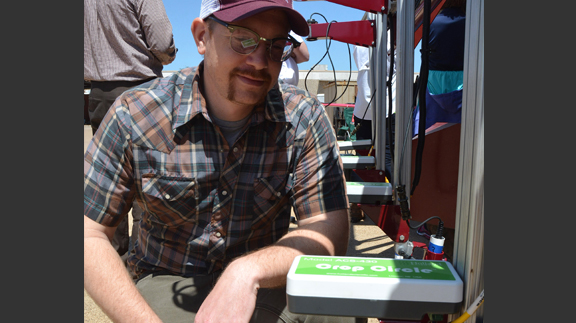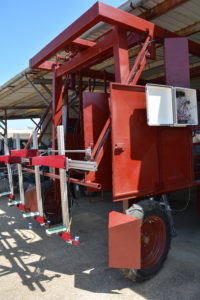Farm & Ranch
[AgriLife Today] AgriLife research remote sensing technology aims to solve critical crop diseases

By: Blair Fannin
- Writer: Blair Fannin, 979-845-2259, [email protected]
- Contact: Dr. Alex Thomasson, 979-458-3598, [email protected]
COLLEGE STATION – Sensor technology could possibly solve many challenges of crop production, and Texas A&M AgriLife Research faculty are aggressively attempting to find new solutions.
Dr. Alex Thomasson, an AgriLife Research biological and agricultural engineer, and Dr. Seth Murray, AgriLife Research corn breeder, both in College Station, and others are working jointly on several projects.
One project, an unmanned ground phenotyping system, provides data that can be used to aid decisions in breeding and production agriculture through techniques like conceptual modeling and spatial prediction, according to the scientists.
“We can also look at other characteristics like the drought tolerance of the plant. The data these machines collect will ultimately enable the breeder to make selections from the best varieties and to do so much quicker.”
Thomasson and other AgriLife and U.S. Department of Agriculture scientists are developing the ability to use remote sensing to detect and treat cotton root rot. Cotton Incorporated has been a strong supporter of this research, some of which is occurring at the Stiles Farm at Thrall.
“The cotton root rot project involves a lot of remote-sensing work to detect the locations of infection within individual fields,” he said. “It’s expensive for cotton farmers, not only the yield losses from the disease but the treatment to prevent it. It’s costing them about $50 an acre to treat the fields, but this research can save them a lot of money by enabling them to treat only the infected areas of a field. Some are trying to use satellite data to identify infected areas, but the image resolution is low. We’ve begun using UAVs (unmanned aerial vehicles), which give us images with extremely high resolution. We have the potential to see where each infected plant is so we can know exactly where to place fungicide in subsequent seasons.”
The remote-sensing research is related to a broader scope of research projects implemented by AgriLife Research. The Texas A&M Coordinated Agricultural Unmanned Aerial Systems project and Ground Vehicle Validation is a collaboration of more than 40 faculty members within the Texas A&M University System.
An unmanned ground phenotyping vehicle is being tested to collect real-time crop data. (Texas A&M AgriLife Research photo by Blair Fannin)
Led by AgriLife Research, the project also involves the Texas A&M Engineering Experiment Station, the Center for Autonomous Vehicles and Sensor Systems, and the Center for Geospatial Applications and Technologies, as well as businesses and farmers. The research centers on 1,400 acres of AgriLife Research fields near College Station where corn, cotton, sorghum and wheat, as well as peaches and perennial grasses are grown.
For more, visit http://bit.ly/1TZMBl1 .
-30-
Find more stories, photos, videos and audio at http://today.agrilife.org
Farm & Ranch
Ag Elsewhere: Wyoming

By Tressa Lawrence
Babies are tucked away in every nook and cranny. Many ranchers across Wyoming have baby animals popping up all over this time of year.
Farm & Ranch
Ag Elsewhere: Montana

By Lindsey Monk
Another load of grain in to keep feeding the calves until the green grass can really start popping.
Farm & Ranch
Meanwhile, Back at the Ranch….

By Rayford Pullen | [email protected]
Spring has sprung and hopefully the rains will continue where our country will heal from the previous droughts and our grasses will thrive. We are especially hopeful for the Panhandle of Texas where our neighbors and friends have been dealt a deadly blow to homes, ranges, livestock, and people. Keep them in your prayers as they will not be able to return to normal for many years if at all. Having lost their ability to benefit from this great cattle market is a double whammy for all of them.
Now is the time of year when we need to take care of business as it relates to our new calves that have been hitting the ground this spring. First and foremost is vaccinating for Blackleg followed by deworming with a white wormer and the IBR complex. Blackleg is a soil-born disease and with pastures extremely short this spring our calves have been grazing the green grass as soon as it shows itself, making them even more vulnerable to picking contaminates from the soil.
To read more, pick up a copy of the April issue of NTFR magazine. To subscribe by mail, call 940-872-5922.
-

 Country Lifestyles1 year ago
Country Lifestyles1 year agoScott & Stacey Schumacher: A Growth Mindset
-

 Equine7 months ago
Equine7 months agoThe Will to Win
-

 Country Lifestyles7 years ago
Country Lifestyles7 years agoStyle Your Profile – What your style cowboy hat says about you and new trends in 2017
-

 Country Lifestyles4 years ago
Country Lifestyles4 years agoAmber Crawford, Breakaway Roper
-

 HOME7 years ago
HOME7 years agoGrazing North Texas – Wilman Lovegrass
-

 Country Lifestyles7 years ago
Country Lifestyles7 years agoDecember 2016 Profile, Rusty Riddle – The Riddle Way
-

 Country Lifestyles8 years ago
Country Lifestyles8 years agoJune 2016 Profile – The man behind the mic: Bob Tallman
-

 Country Lifestyles8 years ago
Country Lifestyles8 years agoCowboy Culture with Clay Reid – Being a Man







